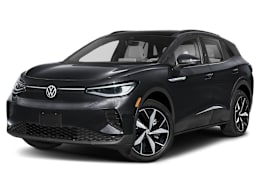The ID.4 is Volkswagen’s first dedicated electric vehicle. We found this small SUV to be quick, quiet, and roomy, and it’s competitively priced. But its unintuitive controls mar the experience. For 2024, the all-wheel-drive ID.4’s EPA-rated 263-mile driving range is competitive.
We think the best option for buyers is to go with the all-wheel-drive model, like the one we tested, which has been bumped to 335-horsepower for 2024. Our tested 2021 model, with 295 horsepower, sprinted from 0 to 60 mph in 5.8 seconds; however, we would expect updated models to be slightly quicker. Power is plentiful with a smooth, linear, and silent punch, without snapping your neck back as some other EVs do. We found the range prediction quite accurate, and the car would cover 250 miles comfortably during typical fall temperatures. We achieved 253 miles in our own 70-mph highway range test with the 2021 ID.4, which had an EPA-estimated range of 240 miles. However, when temperatures got below freezing, we saw less than 200 miles, which is endemic to EVs.
It took us about 8.5 hours to recharge the AWD model’s 82-kilowatt-hour battery from 25-percent remaining using a 240-volt, 32-ampere connection. That’s typical for most EVs, and amounts to about 20 miles of range per hour of charging. For charging on the go, such as during a long trip, VW is giving owners three years of free charging through its subsidiary, Electrify America. ID.4 buyers also benefit from a federal tax incentive of $7,500.
The comfortable-riding ID.4 absorbs most road ruts nicely, especially compared with the stiffer Mustang Mach-E and Tesla Model Y, which kick bumps into the cabin like you’re riding in a sports car. The VW is nimble enough through corners and acquitted itself well around our test track, but there’s noticeable body roll when you pick up the pace, and you can feel the car’s heftiness. Although it’s not as sporty to drive as the Mach-E or Model Y, our testers enjoyed the ID.4’s engaging, rear-wheel-drive-based track manners, which made it fun to drive in spite of the significant body lean. The ID.4 produced competitively short stopping distances compared with other EVs, but you need to push the brake pedal down farther than with most vehicles to slow the ID.4, and the pedal has a spongy feel.
Even by EV standards, the ID.4 is very quiet. The cabin is virtually free of wind, road, and engine noise. However, as soon as the car slows down to about 15 mph, an electric whine—meant to warn pedestrians about the nearly-silent car—sets in, and it isn’t a very pleasant sound.
The cabin is impressively finished in terms of materials, panel fits, and color combinations. The 12-way power front seats in our tested Pro S model are comfortable and supportive, both having the added benefit of four-way lumbar adjustment. The driving position is roomy, the low center console freeing up space for the driver’s right knee. The rear seat is fairly roomy among small SUVs, though it could use more leg support for taller passengers. Cargo capacity is ample, and the hands-free power liftgate that comes on the second-tier Pro S trim opens reliably with a kicking motion under the rear bumper.
But VW’s new infotainment system and other controls are a mess—they are a radical departure from VW’s traditionally easy-to-use layout. The screen is slow to respond and requires multiple actions for common tasks; the temperature adjustment controls aren’t lit at night; and the driver doesn’t have a set of dedicated controls for the rear windows.
Forward collision warning, automatic emergency braking with pedestrian detection, blind spot warning, rear cross traffic warning, lane departure warning, and lane keeping assistance all come standard.























